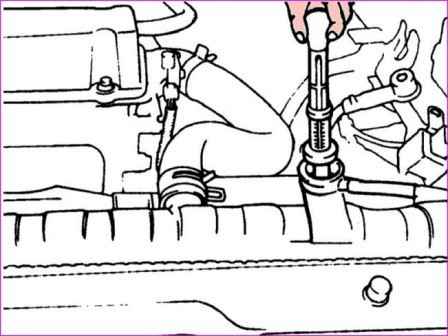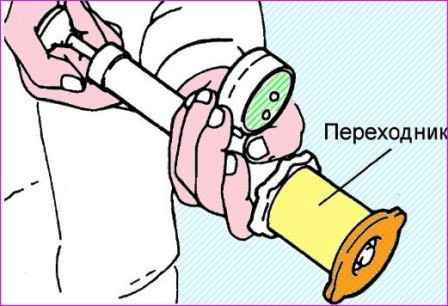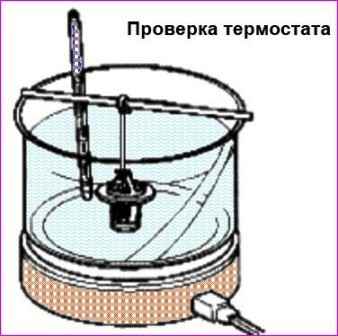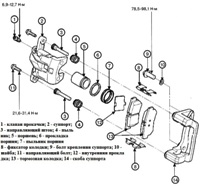Closed cooling system includes water pump, crossflow radiator, radiator fan with electric wire, thermostat, heater core, hoses and sensors
The radiator fan with electric wire turns on when the contact temperature sensor is triggered.
On automatic transmission models, some of the fluid circulates through the transmission fluid cooler.
Technical data
2.0L DOHC Cooling System
Coolant volume 7.3 liters
Thermostat
- - wax filled type
- - opening start temperature, °С 82
- - opening temperature range, °С 80.5–83.5
- - full opening temperature, °C 95
Radiator cap
- - opening pressure of the main valve, kPa 86.1–124.5
- - closing pressure of the main valve, kPa 83.4
- - opening pressure of the vacuum valve, kPa - 6.86
Cooling system V 6 2.5 l
Thermostat
- - opening start temperature, °С 82
- - opening temperature range, °С 80–81
- - full opening temperature, °C 95
Radiator cap
- - opening pressure of the main valve, kPa 86.1–124.5
- - closing pressure of the main valve, kPa 83.4
- - opening pressure of the vacuum valve, kPa - 6.86
Maintenance
Coolant concentration
- - tropical area 40%
- - other areas 50%
Ethylene glycol based coolant
Sealant
Coolant temperature level sensor #2310 or equivalent
LOCTITE 962T coolant temperature sensor or equivalent
Checking the coolant level
Check the coolant level when the engine is cold.
Remove the cap and use the marks on the cap dipstick to determine the coolant level, which should be between the marks F and L.
Add coolant if necessary.
Coolant quality
Check for buildup of rust or scale around the cap or radiator neck.
Check that the coolant is clean and free of contaminants.
Change the coolant if necessary.
Checking the tightness of the cooling system
Remove the radiator cap.
Make sure the coolant level reaches the filler neck.

Mount the radiator cap tester to the filler neck and pressurize the cooling system to 150 kPa.

Check that the pressure in the cooling system is maintained for 2 minutes.
Do not remove the radiator cap when the engine is hot, as escaping vapors can cause severe burns.
Close the radiator cap with a thick rag and slowly unscrew the cap until steam escaping hisses.
After the steam stops escaping, slowly unscrew and remove the cap from the radiator.
Make sure the tested areas are free of moisture.
When the tester is removed, be careful not to spill coolant from the tester.
Be careful when installing and moving the appliance and do not damage the radiator filler when checking.
If not, locate the leak and fix it.
Checking the pressure radiator cap
Use the adapter to attach the radiator cap to the radiator cap tester.

Increase pressure until cap valve moves.
Main valve opening pressure: 96.1-124.5 kPa
Main valve closing pressure: 83.4 kPa
Make sure the valve opens and closes within the specified limits.
Replace the radiator cap if the valve opens and closes outside the specified limits.
Before checking, make sure that the lid is clean and free of rust and foreign matter that could interfere with its operation.
Checking the thermostat
Immerse the thermostat in a tank of water and gradually heat the water

Checking the valve opening temperature.
Standard value 82°C, full opening 95°C
Checking the height of the full opening of the valve: about 8 mm or more at 95 ° C
If the valve opening height does not meet the standard, the thermostat must be replaced
Possible malfunctions of the cooling system
Low coolant level
- - Coolant leak
- - Damaged radiator cells
- - Corroded or cracked hoses (radiator hose, heater hose, etc.)
- - Faulty radiator cap valve or spring installation
- - Faulty thermostat
- - Faulty water pump
Contaminated radiator pipes
Foreign inclusions in the coolant
- Change the coolant
High coolant temperature
- Faulty thermostat
Replace thermostat
- Faulty radiator cap
Replace the radiator cap
- Channels or hoses of the cooling system are clogged
Replace or clean clogged cooling system components
- Drive belt is loose or broken
Adjust the tension or replace the drive belt
- Faulty water pump
Replace water pump
- The coolant temperature sensor or its wiring is faulty
Replace the coolant temperature sensor
- The electric radiator fan or its wiring is faulty
Replace or repair the radiator fan
- The temperature sensor of the radiator fan or its wiring is faulty
Replace the heat sink fan temperature sensor
- Not enough coolant
Add coolant
Low coolant temperature
- Faulty thermostat
Replace thermostat
- The coolant temperature sensor or its wiring is faulty
Replace the coolant temperature sensor
Leaks from the cooling system
- Loose connections
Tighten the connections
- Damaged hoses, pipes or oil cooler
Replace or repair hoses, pipes or oil cooler
Electric radiator fan not working
- Damaged elements
Replace or repair damaged items











